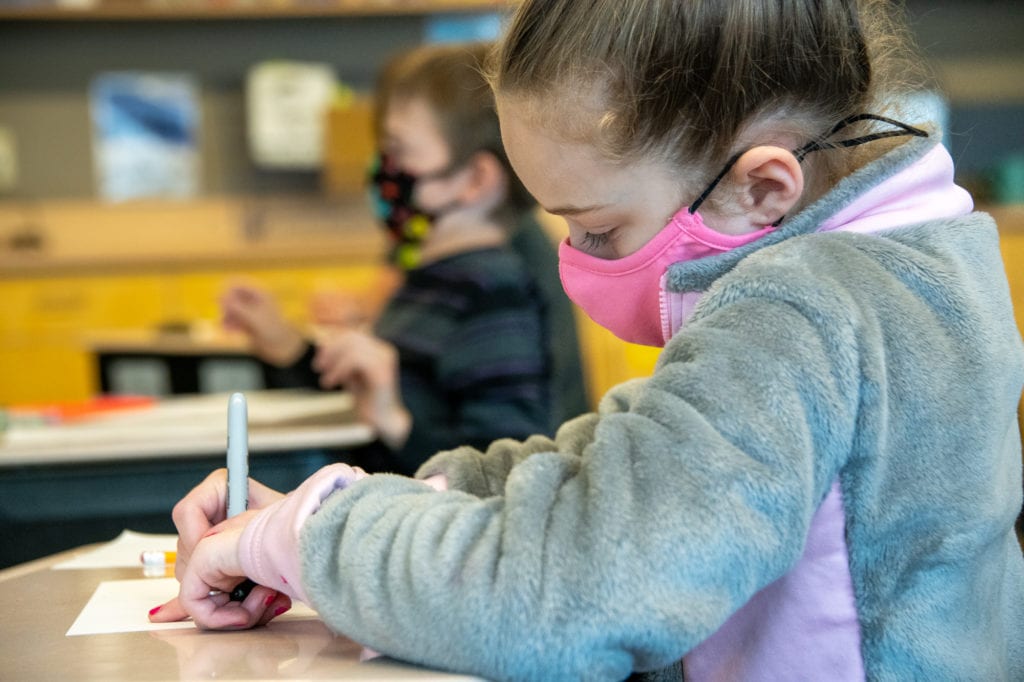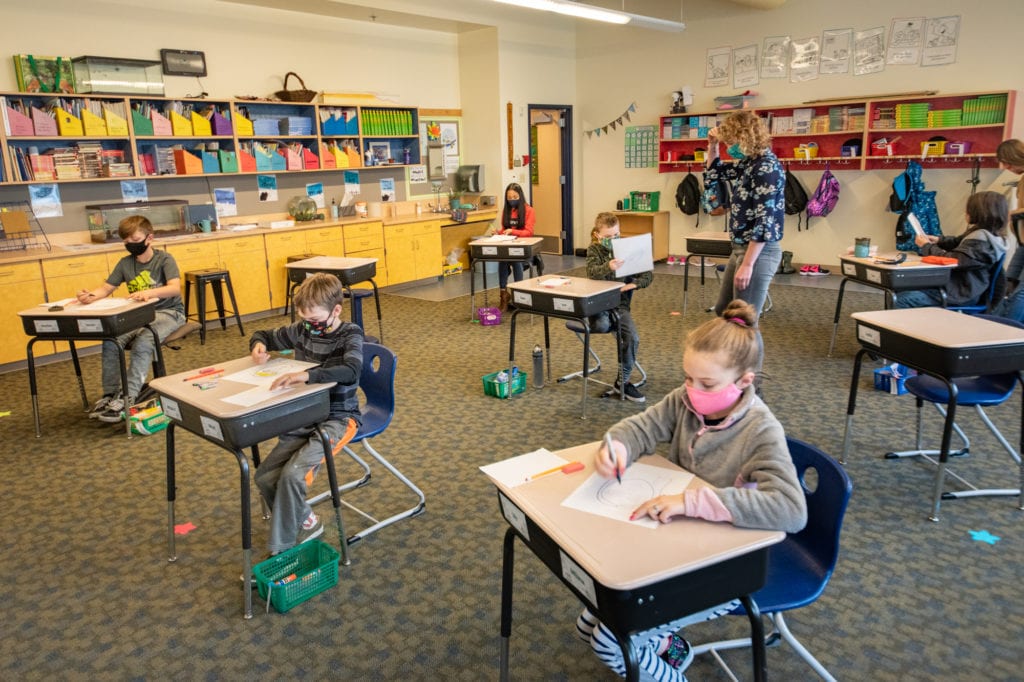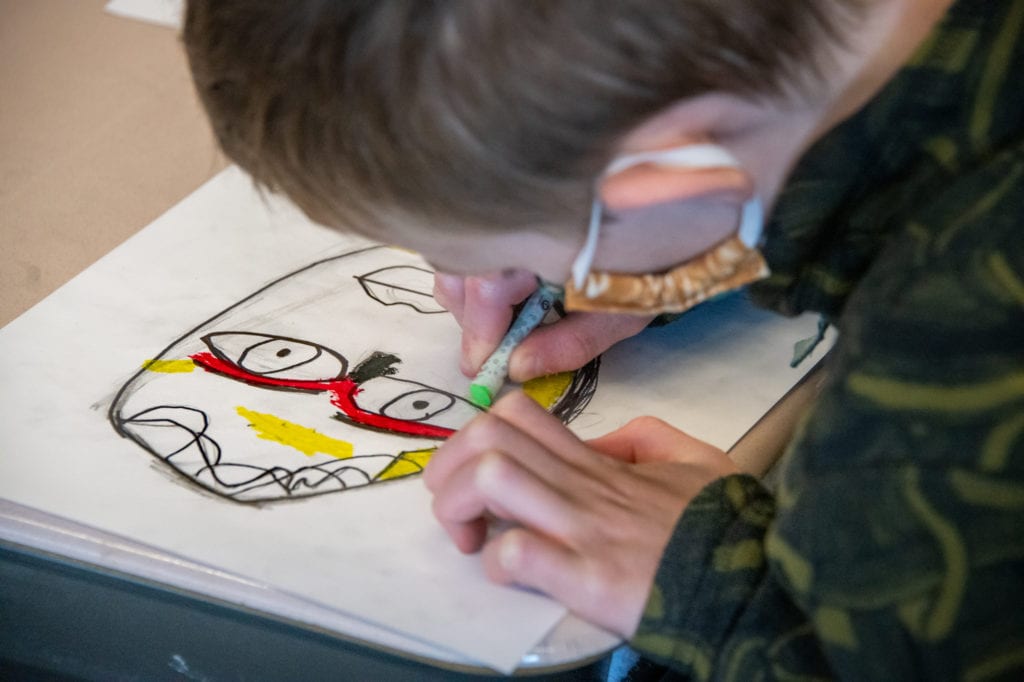
As Cordova strengthened its capacity to deal with the coronavirus, the city’s educators, health care experts and civic leaders approved a reopening of schools. But perhaps the strongest supporters for a return to classrooms have been the students themselves.
Though fourth grader Milana Merritt looks forward to the day when going to class no longer means donning a mask, she was relieved to return to Mt. Eccles Elementary School.
“In PE and stuff, we have to wear a mask when we’re being active, which I don’t like, because it makes me really hot and itchy,” Merritt said. “But I like it here better, because I actually get to see all of my classmates, and, at home, there’s a lot of distractions. I don’t mind wearing a mask if I get to see my friends.”
Following two weeks of online-only teaching, students began their return to classrooms Sept. 7. Students were broken into morning and afternoon instructional groups that limit class sizes, allowing desks to be placed farther apart inside the classroom. Other measures have been taken, such as disinfectant-fogging classrooms deactivating water fountains. Students have worn masks consistently, and staff appreciate smaller instructional groups which allow them to provide more individualized attention to each student, Mt. Eccles Principal Stephanie Milner said.
Cordova has reported 20 cases of the novel coronavirus overall, 19 of which have recovered. Even with encouragingly low virus figures, students are lucky to be attending classes in person, Milner said.
“Alaska’s COVID-19 numbers are on an uptick as we go into cold and flu season, and we are exceedingly fortunate in Cordova to have face-to-face instruction happening, regardless of zero current COVID-19 case numbers in our particular community,” Milner wrote in an email. “I have worked in various places in Alaska, and am seeing my colleagues struggle with being able to have any level of face-to-face instruction. One positive COVID-19 case can mean shifting to online learning for schools in many smaller communities.”

From third graders to high-school seniors, students praised the hard work of staff in implementing sometimes unwieldy new procedures and agreed that returning to classrooms was a welcome relief. Online-only learning has been universally unpopular among students and parents, but accepted as a necessary element of the school district’s phased reopening plan.
Although social-distancing rules can make class awkward, the school is still a welcome refuge from the chaos of society at large, said Andrea Vargas, a senior at Cordova Jr./Sr. High School.
“We’re not accustomed to what’s going on, so we have that awkward feeling,” Vargas said. “Over time, it will normalize… Some people think that school isn’t as fun, but it gives us an escape [from] constantly thinking about all the bad things that are going on in the world, and being able to focus on our schoolwork rather than what’s going on outside.”
Gone — for the moment, at least — are the days when students would play sick to avoid school. Eleventh grader Cody Shaw, who recently returned from a trip to Washington state, said he was impatiently awaiting the negative coronavirus test result that would permit him to return to class. School administrators have managed the situation well, but should allow students to attend class in a single group, rather than in separate morning and afternoon shifts, he said. Even when he returns to the classroom as part of the afternoon group, Shaw will still be separated from most of his friends, who are in the morning group.
“I hope — and I’m sure a lot of other students hope — that, at least by next year, it’ll be back to normal and not have to worry about all these mandates,” Shaw said.
Fourth grader Tyler Calfina, who attends class during the afternoon, also found himself separated from his best friend, who is part of the morning group. Nonetheless, Calfina was pleased to be back among his peers, and said that new rules were easy to remember and follow.
“It’s not that hard, honestly,” sixth grader Aiden Flores said. “Some people are just really crazy about it. If you’re just safe, with masks and hand sanitizer, it’s really fine.”
While many students said they would prefer a quicker and more complete reopening, few believed the school district’s phased reopening plan was entirely ill-conceived. Third grader Astrid Wasson suggested reducing social distancing from 6 feet to 3 feet, while one of her classmates said the school’s drinking fountains should be reactivated — and made to dispense chocolate rather than water.

Some children find themselves chiding the hygiene not just of their classmates, but of adults as well. When fourth grader Milana Merritt’s family members traveled to Anchorage, Merritt said she took it upon herself to make sure they applied proper sanitation measures.
“Before they went, I was like, ‘Okay, you need to wash your hands, you need to do all this,’ because they are healthy — really healthy, we all are — but it’s scary,” Merritt said. “It’s like one more thing to worry about… I think it’s very difficult for kids, because when my mom and them were younger, they never had to go through any of this. My parents say it’s unfair for us to live this way.”
For students, returning to classrooms has meant a partial return to normal life. But the chaos of the coronavirus pandemic, as well as the other crises gripping the nation’s attention, also present students an opportunity to grow and strengthen themselves, Vargas suggested.
“Although it is a completely crappy experience to go through, it’s what builds us,” Vargas said. “It’s going to be part of our childhood. We just need to show that we were able to get through it. Although it would have been easier if we’d grown up a decade ago, we have to learn to accept that it is what we have to deal with.”





